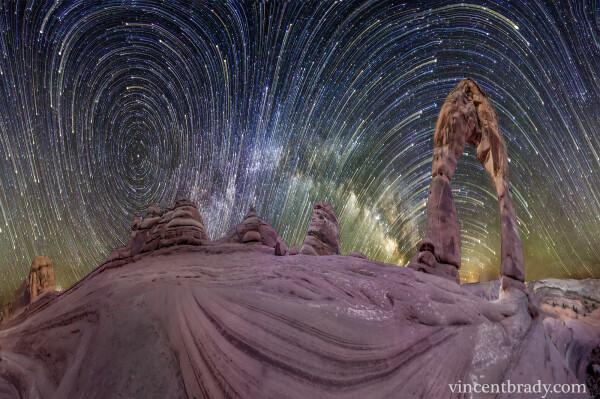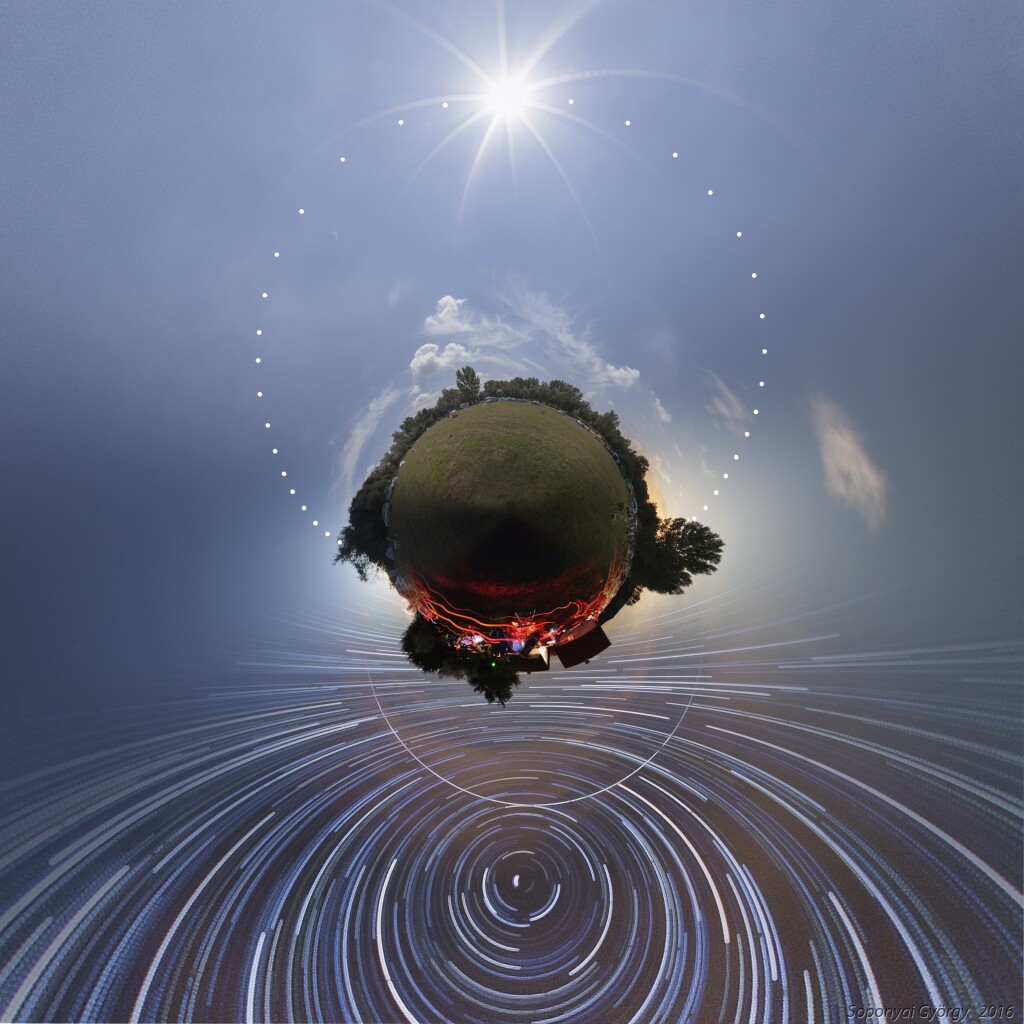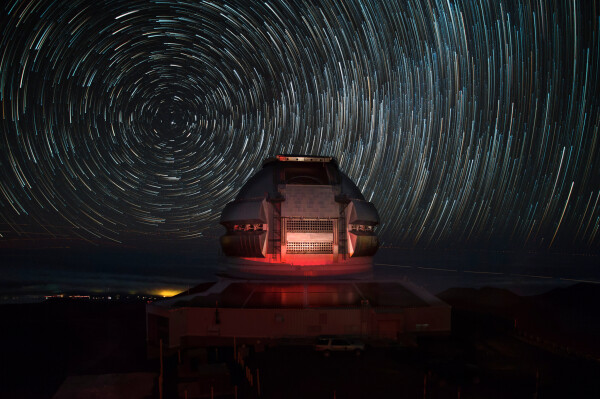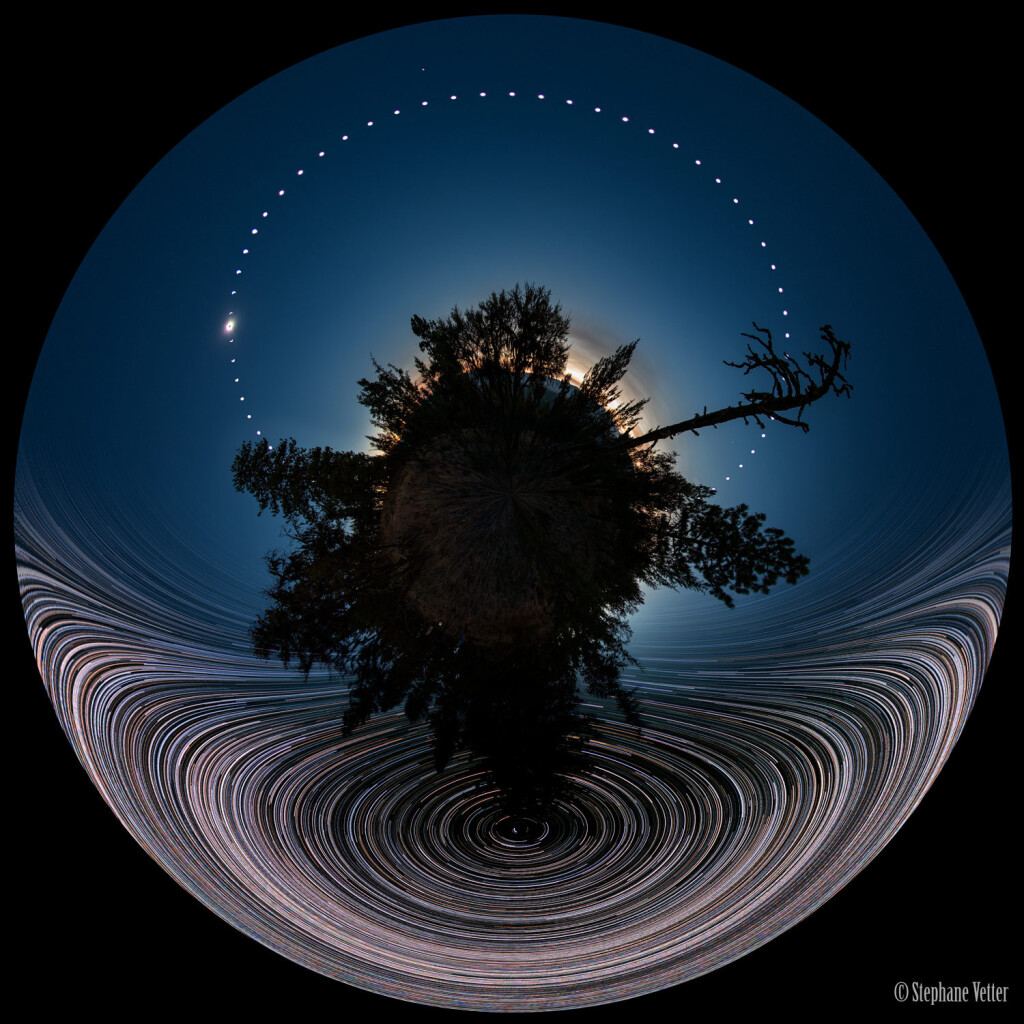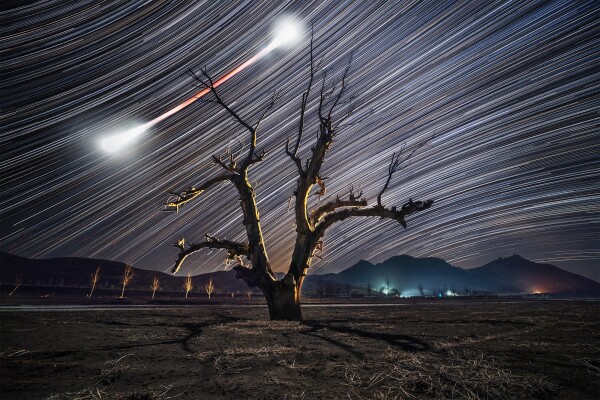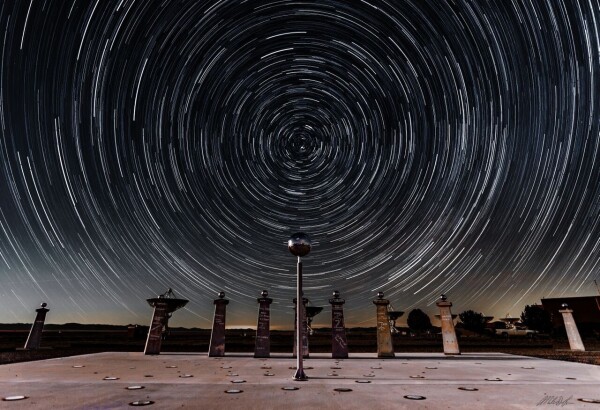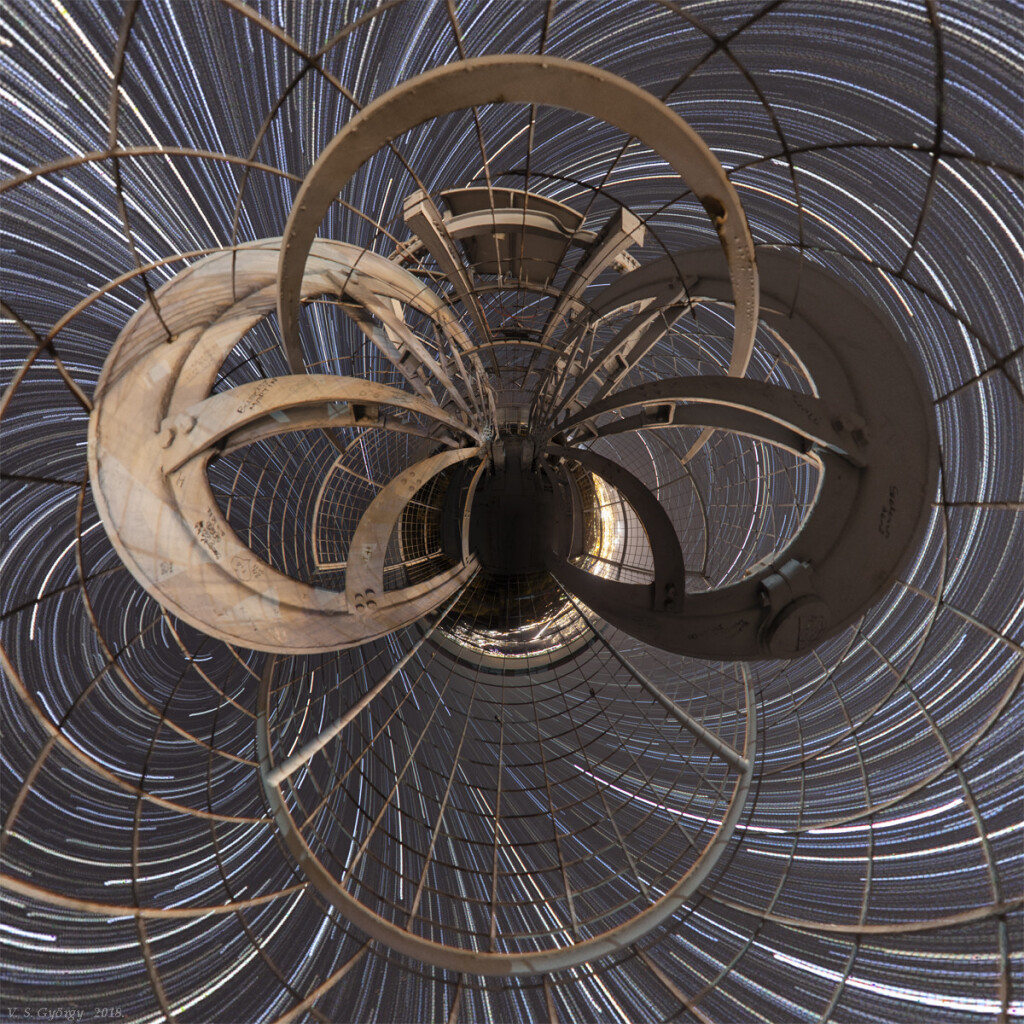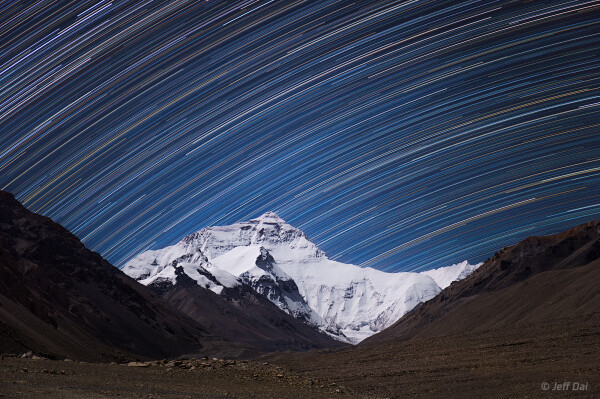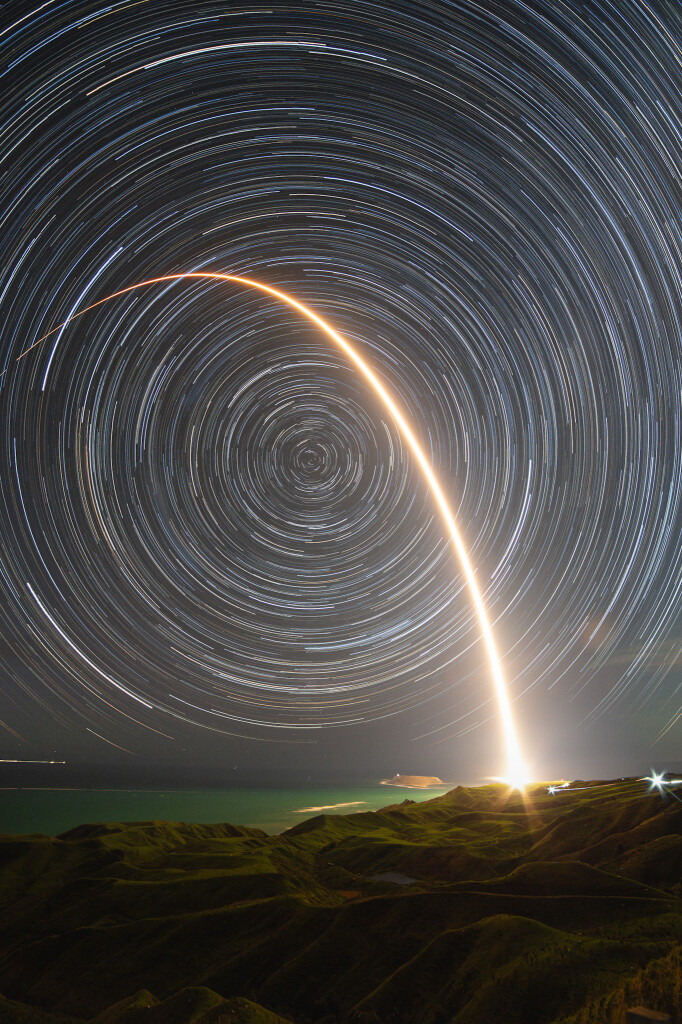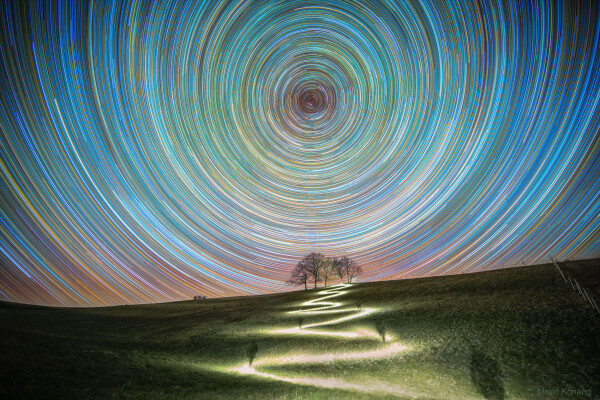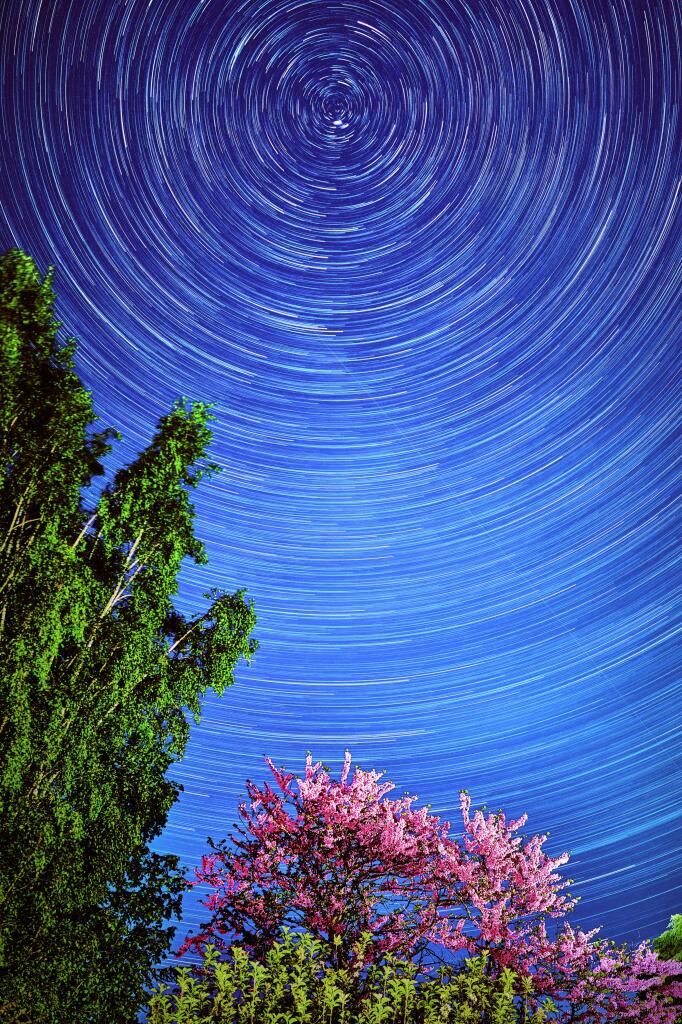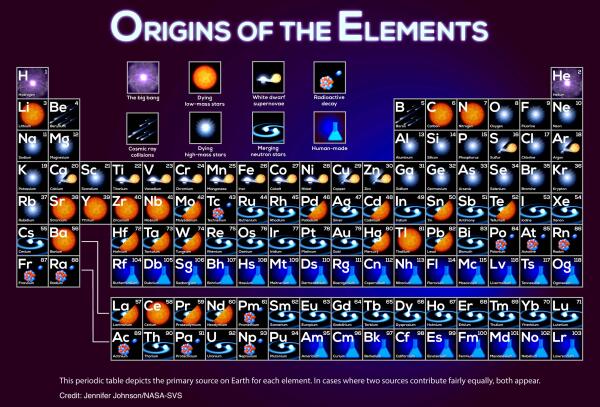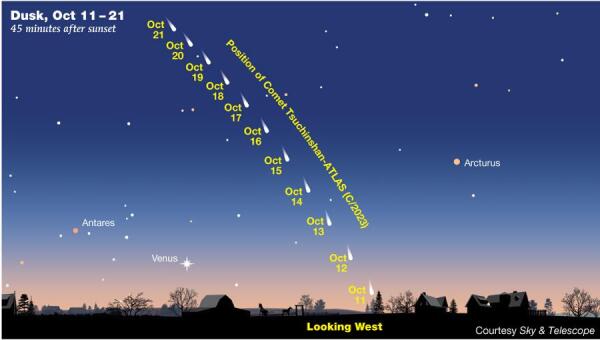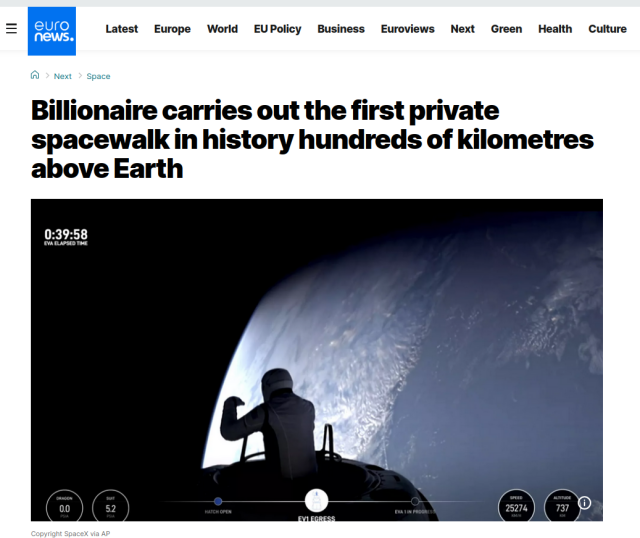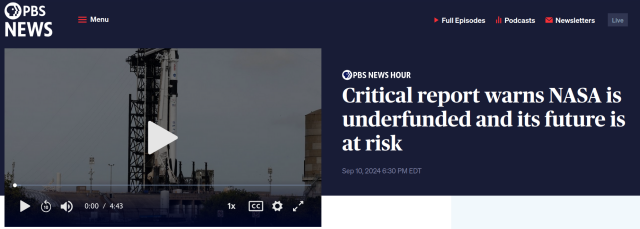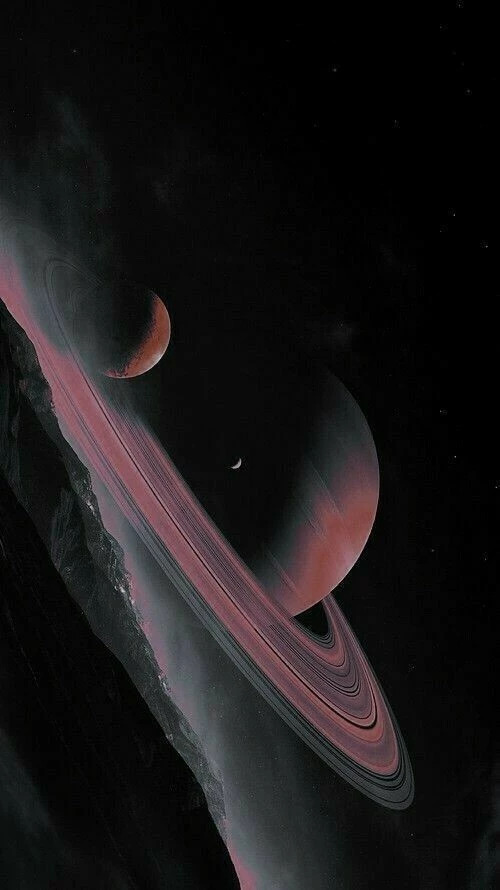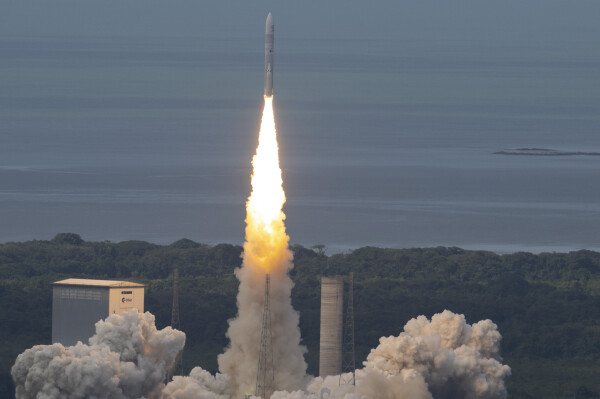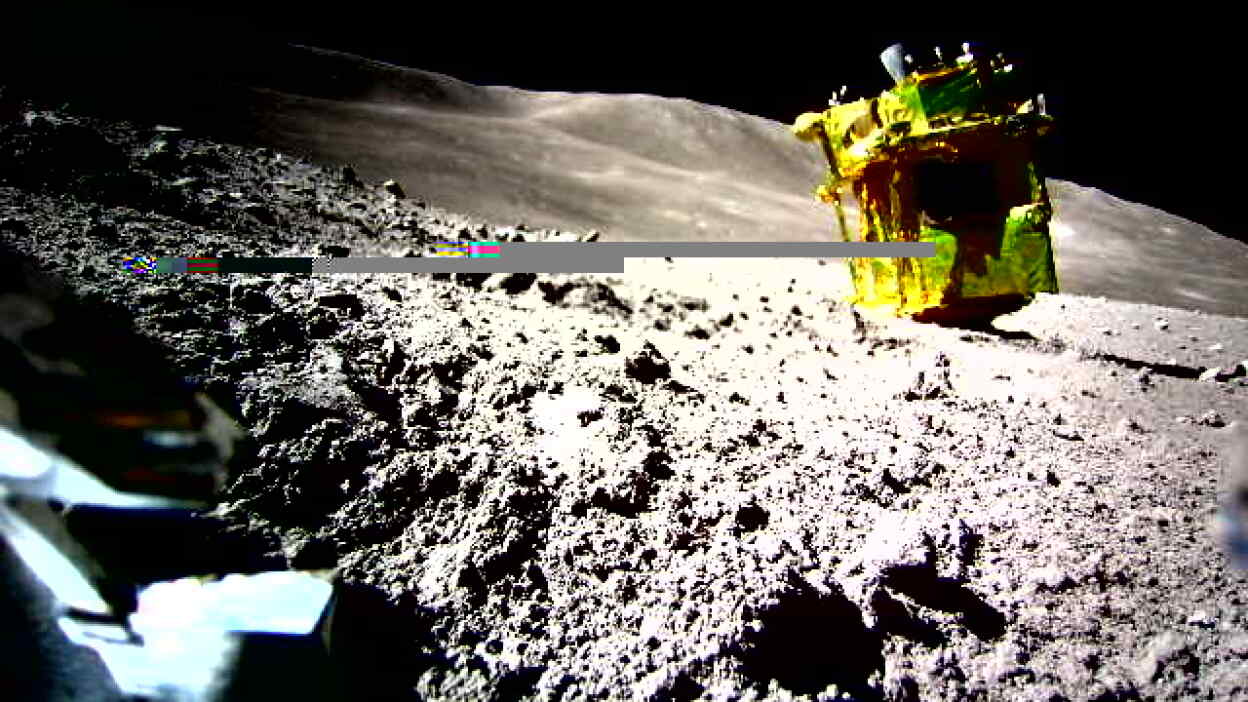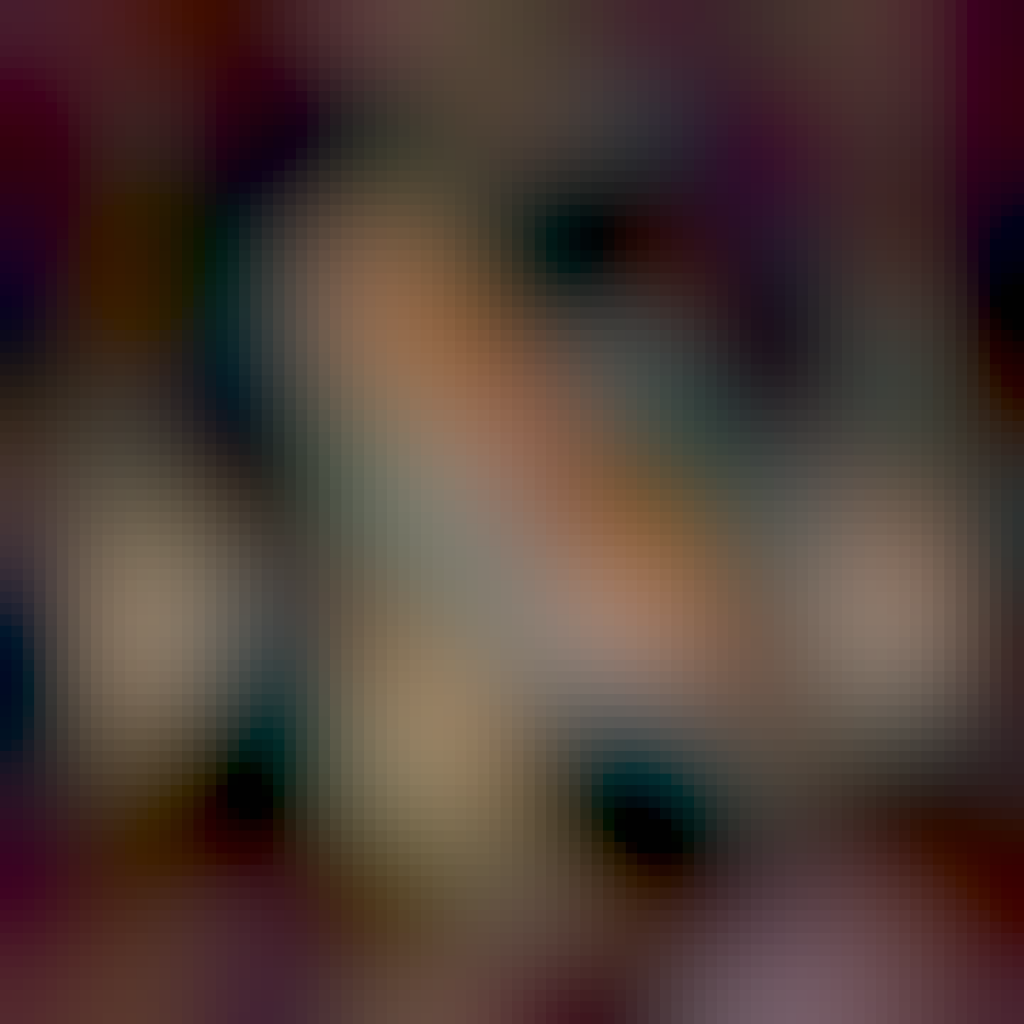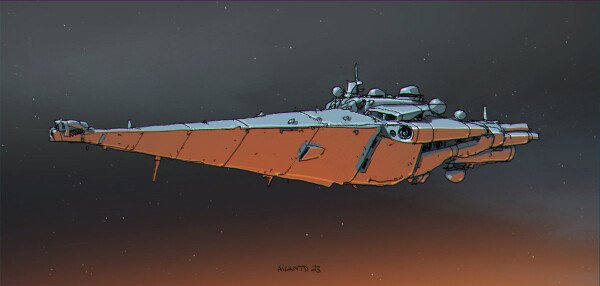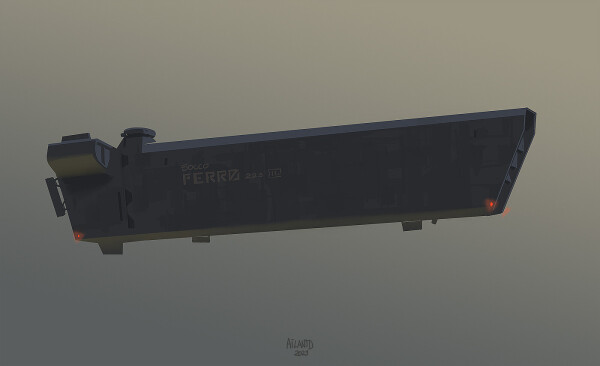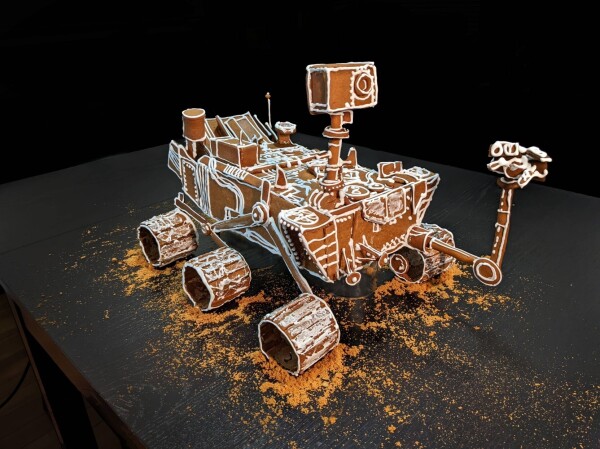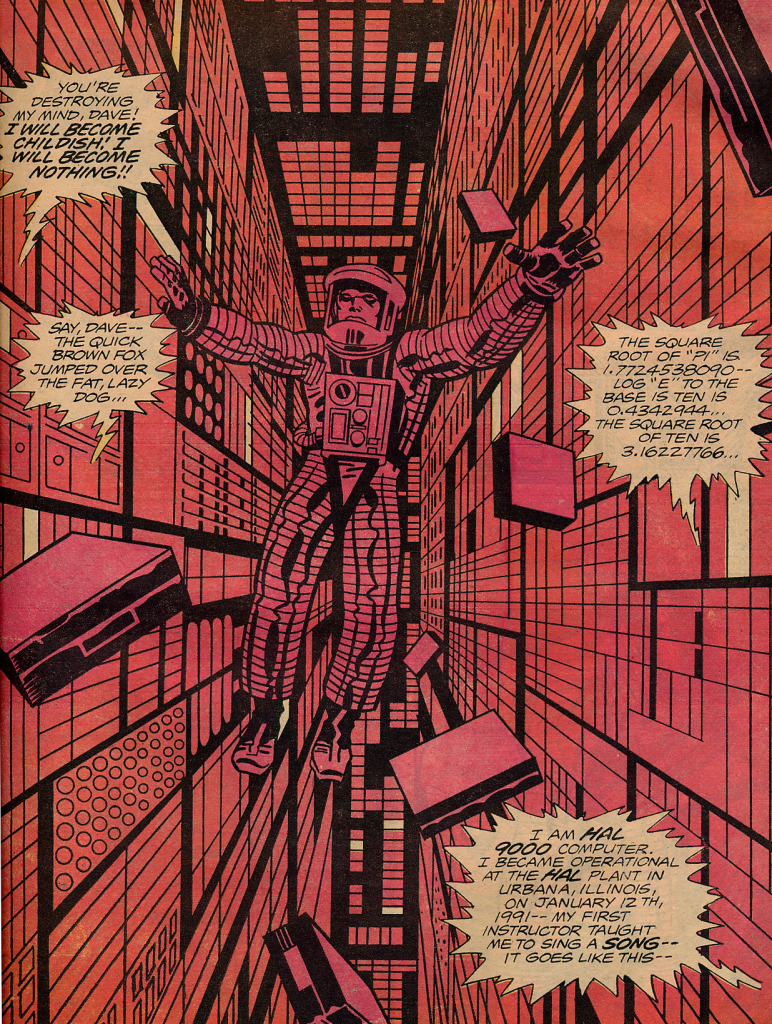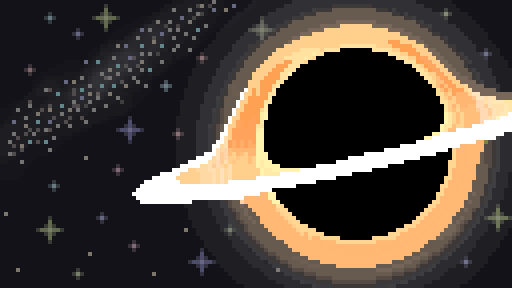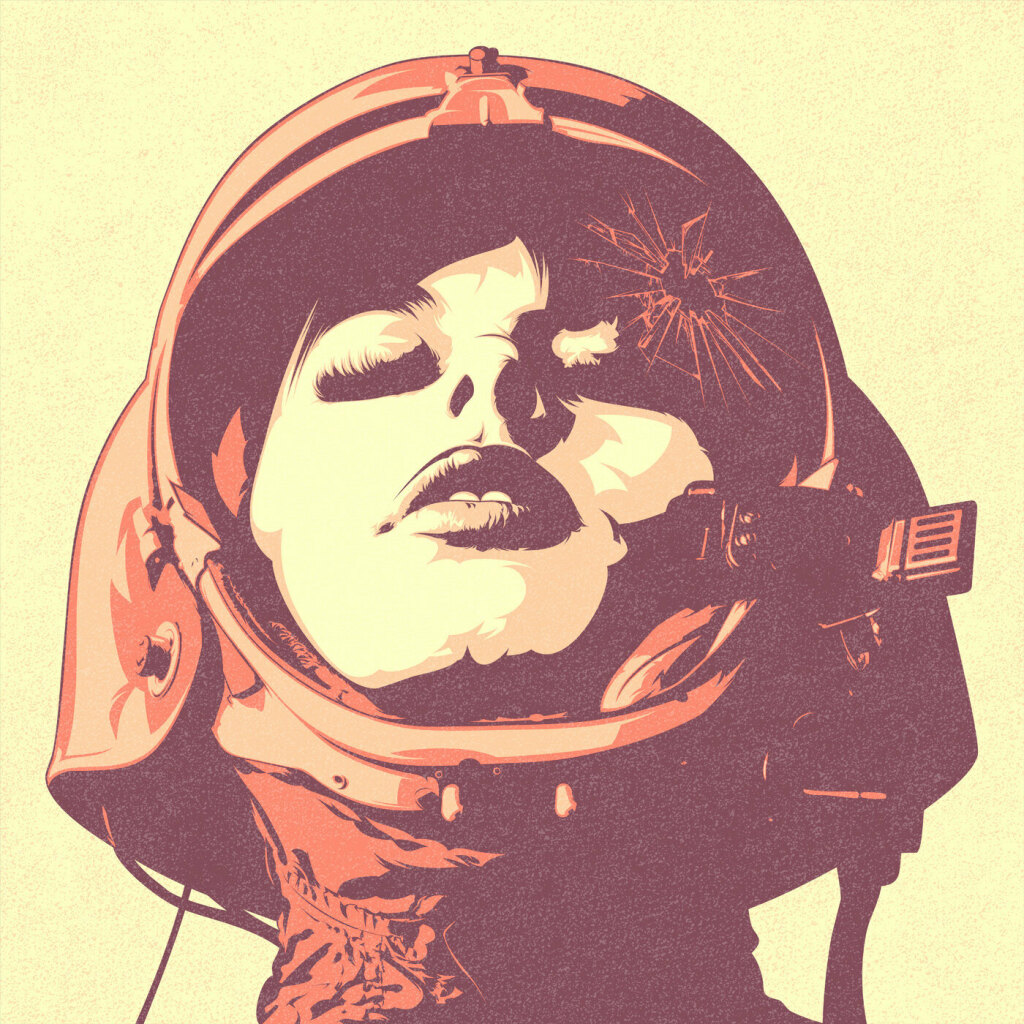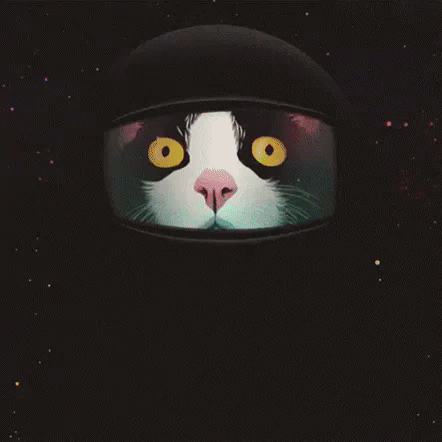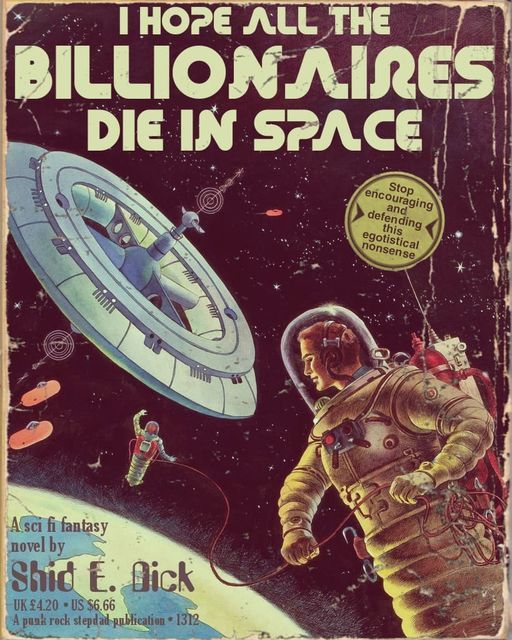Search
Items tagged with: Space
Warped Sky: Star Trails over Arches National Park
* Image Credit & Copyright: Vincent Brady
Explanation:
What's happened to the sky? A time warp, of sorts, and a digital space warp too. The time warp occurs because this image captured in a single frame a two and a half hour exposure of the night sky. As a result, prominent star trails are visible. The space warp occurs because the picture is actually a full 360 degree panorama, horizontally compressed to fit your browser. As the Earth rotated, stars appeared to circle both the North Celestial Pole, on the left, and the South Celestial Pole, just below the horizon on the right. The above panorama over Arches National Park in Utah, USA, was captured two weeks ago during early morning hours. While the eye-catching texture of ancient layered sandstone covers the image foreground, twenty-meter tall Delicate Arch is visible on the far right, and the distant arch of our Milky Way Galaxy is visible near the image center.
https://apod.nasa.gov/apod/ap140317.html
#space #earth #astrophotography #photography #astroart #art #science #nature
APOD: 2014 March 17 - Warped Sky: Star Trails over Arches National Park
A different astronomy and space science related image is featured each day, along with a brief explanation.apod.nasa.gov
Little Planet Astro Camp
* Image Credit & Copyright: György Soponyai
Explanation:
Day and night on this little planet look a lot like day and night on planet Earth. In fact, the images used to construct the little planet projection, a digitally warped and stitched mosaic covering 360x180 degrees, were taken during day and night near Tarján, Hungary, planet Earth. They span a successful 33-hour-long photo experiment at July's Hungarian Astronomical Association Astro Camp. The time-series composite follows the solar disk in 20 minute intervals from sunrise to sunset and over six hours of star trails in the northern night sky centered on the North Celestial Pole near bright star Polaris. The orbiting International Space Station traced the offset arc across the northern night. Below the little planet's nightside horizon, red light lamps of fellow astro-campers left the night-long, dancing trails.
https://apod.nasa.gov/apod/ap160902.html
#space #earth #astrophotography #photography #astroart #art #science #nature
APOD: 2016 September 2 - Little Planet Astro Camp
A different astronomy and space science related image is featured each day, along with a brief explanation.apod.nasa.gov
APOD: 2016 October 15 - Gemini Observatory North
A different astronomy and space science related image is featured each day, along with a brief explanation.apod.nasa.gov
APOD: 2017 August 30 - Panoramic Eclipse Composite with Star Trails
A different astronomy and space science related image is featured each day, along with a brief explanation.apod.nasa.gov
Bow Tie Moon and Star Trails
* Image Credit & Copyright: Haitong Yu
Explanation:
On January 31, a leisurely lunar eclipse was enjoyed from all over the night side of planet Earth, the first of three consecutive total eclipses of the Moon. This dramatic time-lapse image followed the celestial performance for over three hours in a combined series of exposures from Hebei Province in Northern China. Fixed to a tripod, the camera records the Full Moon sliding through a clear night sky. Too bright just before and after the eclipse, the Moon's bow tie-shaped trail grows narrow and red during the darker total eclipse phase that lasted an hour and 16 minutes. In the distant background are the colorful trails of stars in concentric arcs above and below the celestial equator.
https://apod.nasa.gov/apod/ap180208.html
#space #earth #astrophotography #photography #astroart #art #science #nature
APOD: 2018 February 8 - Bow Tie Moon and Star Trails
A different astronomy and space science related image is featured each day, along with a brief explanation.apod.nasa.gov
APOD: 2018 July 13 - Star Trails and the Bracewell Radio Sundial
A different astronomy and space science related image is featured each day, along with a brief explanation.apod.nasa.gov
Little Planet Lookout
* Image Credit & Copyright: Gyorgy Soponyai
Explanation:
Don't panic. This little planet projection looks confusing, but it's actually just a digitally warped and stitched, nadir centered mosaic of images that covers nearly 360x180 degrees. The images were taken on the night of October 31 from a 30 meter tall hill-top lookout tower near Tatabanya, Hungary, planet Earth. The laticed lookout tower construction was converted from a local mine elevator. Since planet Earth is rotating, the 126 frames of 75 second long exposures also show warped, concentric star trails with the north celestial pole at the left. Of course at this location the south celestial pole is just right of center but below the the little planet's horizon. the little planet's horizon.
https://apod.nasa.gov/apod/ap181109.html
#space #earth #astrophotography #photography #astroart #art #science #nature
APOD: 2018 November 9 - Little Planet Lookout
A different astronomy and space science related image is featured each day, along with a brief explanation.apod.nasa.gov
Mount Everest Star Trails
* Image Credit & Copyright: Jeff Dai (TWAN)
Explanation:
The highest peak on planet Earth is framed in this mountain and night skyscape. On September 30, the digital stack of 240 sequential exposures made with a camera fixed to a tripod at an Everest Base Camp captured the sheer north face of the Himalayan mountain and foreground illuminated by bright moonlight. Taken over 1.5 hours, the sequence also recorded colorful star trails. Reflecting the planet's daily rotation on its axis, their motion is along gentle concentric arcs centered on the south celestial pole, a point well below the rugged horizon. The color of the trails actually indicates the temperatures of the stars. Blueish hues are from hotter stars, and yellow to reddish hues are from stars cooler than the Sun.
https://apod.nasa.gov/apod/ap181201.html
#space #earth #astrophotography #photography #astroart #art #science #nature
APOD: 2018 December 1 - Mount Everest Star Trails
A different astronomy and space science related image is featured each day, along with a brief explanation.apod.nasa.gov
Sky Full of Arcs
* Image Credit & Copyright: Rory Gannaway
Explanation:
On August 11 a Rocket Lab Electron rocket launched from a rotating planet. With a small satellite on board its mission was dubbed A Sky Full of SARs (Synthetic Aperture Radar satellites), departing for low Earth orbit from Mahia Peninsula on New Zealand's north island. The fiery trace of the Electron's graceful launch arc is toward the east in this southern sea and skyscape, a composite of 50 consecutive frames taken over 2.5 hours. Fixed to a tripod, the camera was pointing directly at the South Celestial Pole, the extension of planet Earth's axis of rotation in to space. But no bright star marks that location in the southern hemisphere's night sky. Still, the South Celestial Pole is easy to spot. It lies at the center of the concentric star trail arcs that fill the skyward field of view.
https://apod.nasa.gov/apod/ap240817.html
#space #earth #astrophotography #photography #astroart #art #science #nature #education
APOD: 2024 August 17 - Sky Full of Arcs
A different astronomy and space science related image is featured each day, along with a brief explanation.apod.nasa.gov
APOD: 2020 February 12 - Star Trails of the North and South
A different astronomy and space science related image is featured each day, along with a brief explanation.apod.nasa.gov
APOD: 2020 April 7 - A Path North
A different astronomy and space science related image is featured each day, along with a brief explanation.apod.nasa.gov
Canon EOS R7 + RF 28mm F2.8 STM.
28mm, f2.8, 10 exposures of 600’’.
#canon #canoneosr7 #eosr7 #astro #astrophoto #astrophotos #astrophotography #astrophotographer #spacephotography #astronomy #spaceexploration #nasa #universe #space #deepsky #deepspace #star #stars #startrail #startrails
I want to give #Mastodon a proper go this time, but it's hard to connect with people when no-one follows you, and hashtags only get you so far. 😞
So, if you like one of the hashtags below, please consider following me, and if you do, I'll follow you back! Thank you. 💗
#retrocomputing #msdos #windows #vintagecomputing #ai #lego #scifi #amiga #linux #doctorwho #drwho #startrek #starwars #space #uk #lgbtq #3dprinting #woodworking #discworld #reading
“In everyone’s pocket right now is a computer far more powerful than the one we flew on Voyager. I don’t mean your cell phone — I mean the key fob that unlocks your car.”
— Rich Terrile, JPL scientist and member of the Voyager imaging team
You've probably heard that "we are stardust," but this graphic breaks it down further & tells you what kind of stars your dust came from--and which elements didn't come from stars at all.
https://svs.gsfc.nasa.gov/13873/ #science #nature #space
Periodic Table of the Elements: Origins of the Elements
This periodic table depicts the primary source on Earth for each element. In cases where two sources contribute fairly equally, both appear. || PeriodicTableOrigins2_print.jpg (1024x682) [251.7 KB] || PeriodicTableOrigins2_Large.NASA Scientific Visualization Studio
I feel like we could all use some good news right now, so here you go: Bright comet Tsuchinshan-ATLAS will become visible in the evening sky starting tomorrow night.
Clear view to the west essential. Sharp eyes highly recommended. Pointers at the link.
https://skyandtelescope.org/press-releases/bright-comet-evening-view/ #space #science #astronomy #nature #photography
The world is indeed becoming like a really bad bad dark comedy.
I suggest they take a shit from there to see how it lands on Earth. They are already shitting all over the planet anyway...
At the same time:
Yeah....not much can be said...
#nasa #space #spacex #billionairs #capitalism
👨🚀🚀 3... 2... 1... Liftoff!
Last night, Europe's new heavy-lift rocket, #Ariane6, successfully made its inaugural flight.
Ariane 6 can launch both heavy and light payloads to a wide range of orbits for applications such as Earth observation, telecommunication, meteorology, science and navigation.
It is a key step towards secure and autonomous 🇪🇺 access to #space.
Congratulations to the teams at European Space Agency, National Centre for Space Studies, Arianespace on this success!
📷© ESA
Still some hope. Also a chance for some robotic gallows humor, I suppose. The robots did deploy, even though the craft landed basically upside down.
Japan’s moon landing picture might be the space photo of the decade | Mashable • https://mashable.com/article/japan-moon-landing-recent-images
#space #moon #mission #japan
Japan’s moon landing picture might be the space photo of the decade
It's really hard to touch down on the lunar surface.Elisha Sauers (Mashable)
The "USS Western Morals" warship captured while departing Red City, just few days before her sudden disappearance.
While the incident is still under investigation, feel free to reply with your own theory about what happened.
Quick digital color over this one before ending the day.
#scifiart #spaceship #space #spacefiction
The Siena Galaxy Atlas contains the most precise overview of galaxies in the nearby universe: 380,000 of them, each one as vast and storied as our own Milky Way. https://noirlab.edu/public/news/noirlab2328/
#space #science #astronomy
New Siena Galaxy Atlas Delivers Improved Measurements of Almost 400,000 Nearby Galaxies - The unprecedented digital atlas includes data from NOIRLab telescopes and will be an invaluable resource for research into galaxy formation and the structure of the
Astronomers have created a detailed atlas of almost 400,000 galaxies in our cosmic neighborhood. The Siena Galaxy Atlas was compiled using data from NSF's NOIRLab telescopes, and is designed to be the pre-eminent digital galaxy atlas for large galaxi…www.noirlab.edu
Digital color over doodle. I tried to keep this one simple and stylized.
#scifi #spaceship #space #conceptart #scifiart
One of the best interviews I have listend to this year.
#space #spacerace #capitalism #religion #colonialism @parismarx
https://techwontsave.us/episode/169_the_dangerous_religion_of_the_corporate_space_race_w_mary_jane_rubenstein

The Dangerous Religion of the Corporate Space Race w/ Mary-Jane Rubenstein - Tech Won’t Save Us
Elon Musk and Jeff Bezos want us to colonize space, but where do their ideas come from? Mary-Jane Rubenstein explains how they're building on frameworks that justified European colonization and why we need to challenge them.Tech Won't Save Us
Credit: NASA, ESA, and F. Summers
Source: https://svs.gsfc.nasa.gov/30686
#Astronomy #Space #Universe #AltText4Me
🚀 We cover all the developments happening in commercial/gov/mil space around the world AND I talk to the people who are making it happen. Every day!
It's available on all major podcast platforms, and I hope you'll listen in.
https://space.n2k.com/podcasts/t-minus
#podcast #TMinusSpaceDaily #spacepodcast
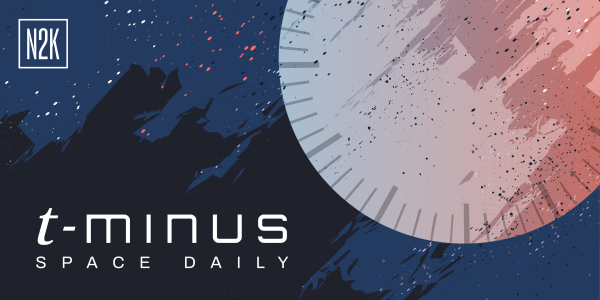
T-Minus, the Only Daily Space Intelligence Podcast | N2K Space
Every weekday, Maria Varmazis, the host of T-Minus, relays the latest news and insights along with leading experts from industry, academia, research organizations, and more.space.n2k.com
What could be emptier than a black hole?
#inktober #inktober2022 #art #pixelart #fediart #mastoart #space
(14/31)
via @dubiousdisc@im-in.space
Darshak Parikh (@dubiousdisc@im-in.space)
Attached: 1 image Day 14 prompt: #empty What could be emptier than a black hole? #inktober #inktober2022 #art #pixelart #fediart #mastoart #space (14/31)I'm in Space
#digitalart #art #space #odyssey #scifi #CranioDsgnStudio
CranioDsgnStudio
meine #friendca instanz läuft nun seit ca. 7 Monaten und die Datenbank wächst und wächst ... aktuell liegt die bei ca. 11 GB - gibt es da keinen Job der die Datenbank wieder verkleinert - weil sonst laufe ich irgendwann Space out ...
Für die Accounts habe ich schon eine aufbewahrung von Beiträgen von 90 Tagen eingestellt (vorher waren das mal 365 dann 180 Tage)
#friendica #db #space
